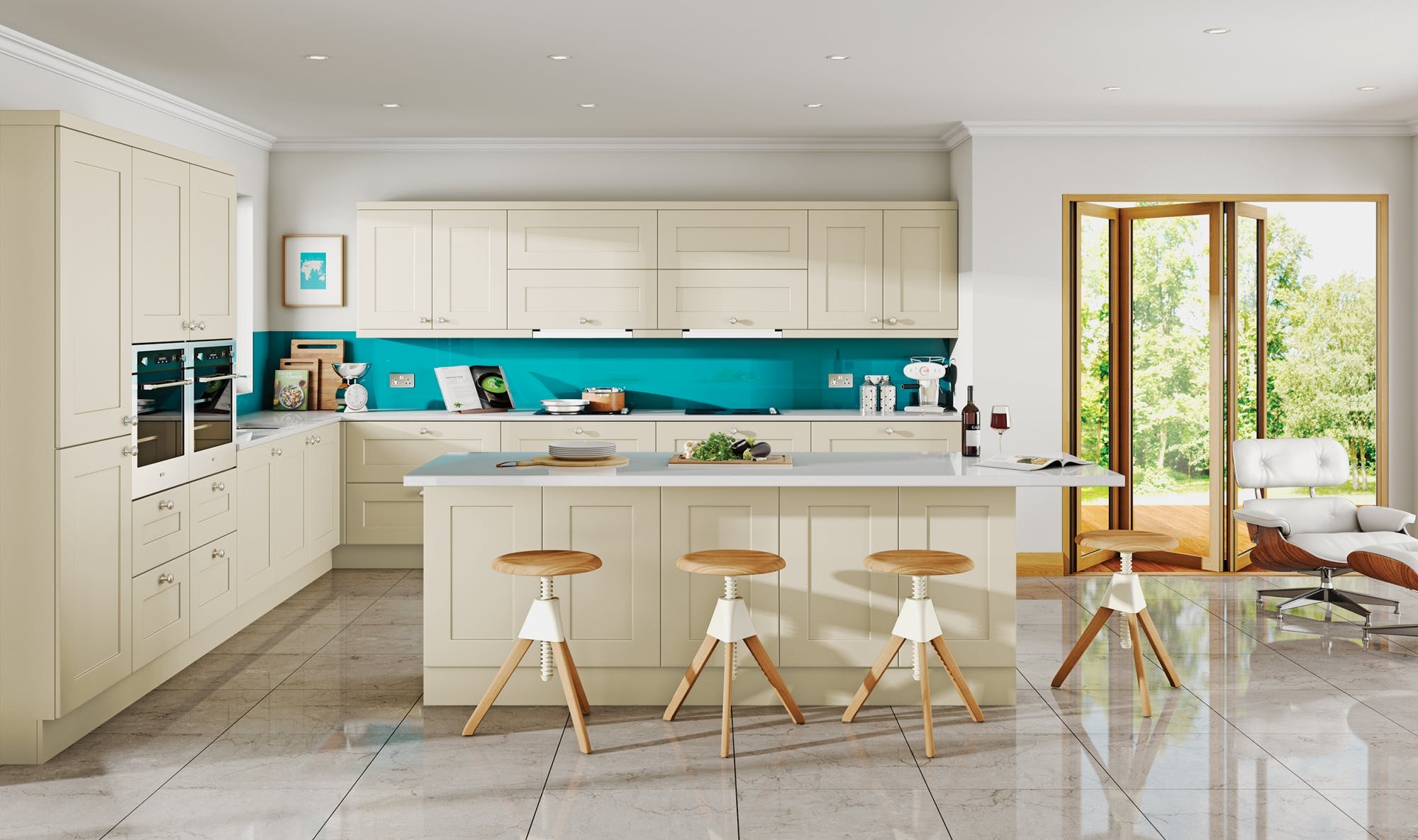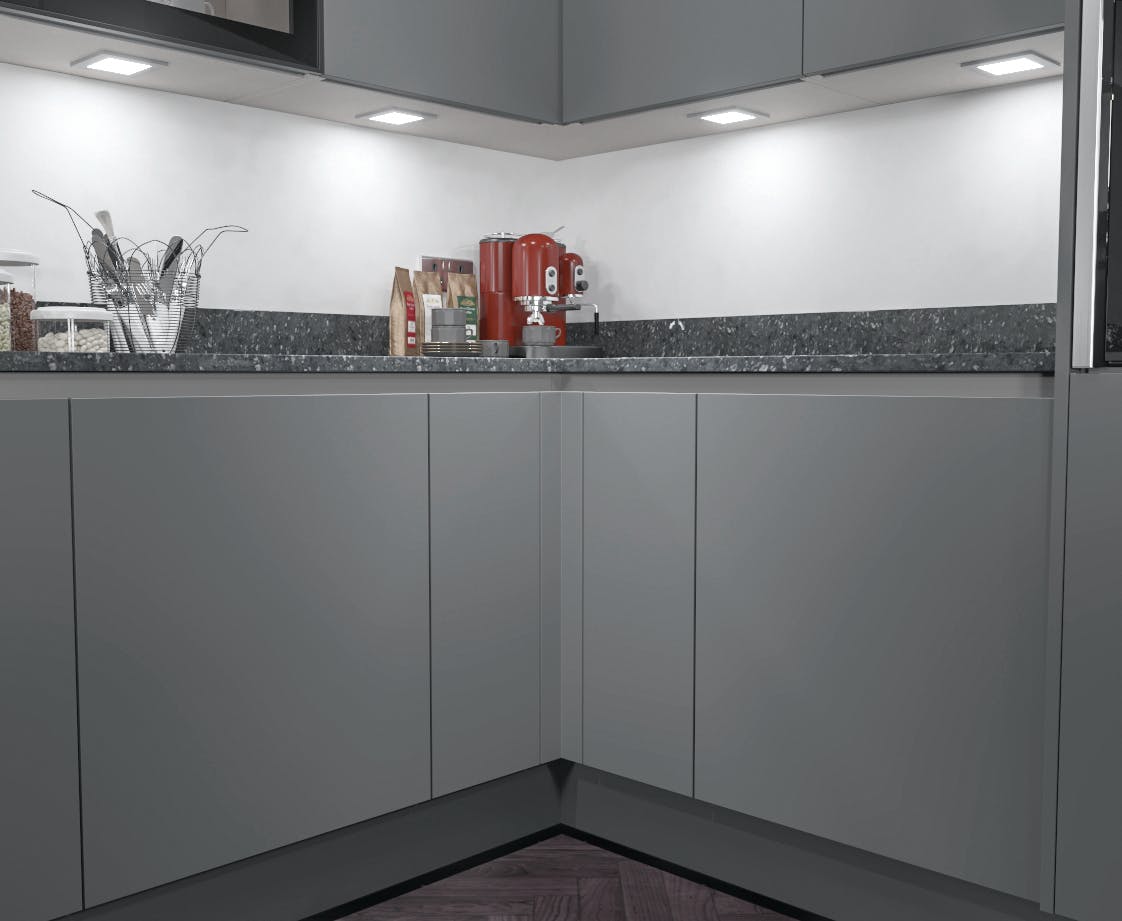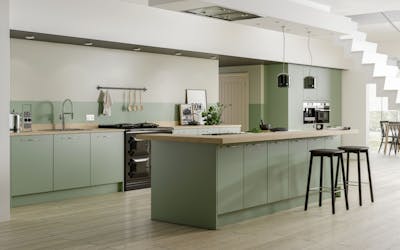10 Ways To Be Sustainable In The Kitchen | More Kitchens
Published: 26 April 2023

Unsurprisingly, there has been a sharp increase in the amount of UK homeowners wanting to know how to be more sustainable in the kitchen.
In the past 12 months (April 2022 - April 2023), there has been a 25% increase in searches around the topic. There’s a clear shift towards trying to balance the scales of having a beautiful and stylish kitchen space that is also being used in a more efficient and greener way.
But what does it mean to be more sustainable in the kitchen?
To us, it goes far beyond just eating greener. Having an eco-friendly kitchen also factors in the appliances we use and how we use them on a daily basis. Then there are the materials we use, making a conscious decision to dodge the use of toxic cleaning chemicals and making better choices that benefit both your pocket but also the planet.
With so much to consider, we share our top 10 tips on how you can be more sustainable in your kitchen…
Top tips for creating an eco-friendly kitchen
As already mentioned, this blog is going to cover a wide breadth of areas for you to consider.
We have broken this down into our top 10 tips, which will cover everything you need to know from cooking more efficiently to choosing the right appliances to water conservation and switching to reusable.
Without further ado, let’s dive straight in.
1) Reduce food waste
One of the most important steps you can take to create a more sustainable kitchen is to reduce your food waste.
Shockingly, data from 2022 showed the UK generated over 9.5 million tonnes of food waste, with 70% of that figure coming from households. But what does this have to do with being sustainable? Taking the above number into account, the amount of carbon being generated by wasted food in the UK is comparable to that released by one fifth of the country's vehicles on the road.
In summary, reducing the food we waste is an easy but incredibly effective first step to make.
Reducing food waste can be done in a variety of ways, such as meal planning, buying only what you need, and making sure you use up all of your leftovers. Additionally, you can compost any food scraps or donate excess food to food banks.
It’s also worth including your refrigerator here. By choosing a design with multiple cavities you can keep fresh food for longer and have the room to store batch-cooked meals which saves both time and prevents food waste.
2) Ditch single-use for reusable products
Reusable products are becoming increasingly important in the mission to cut down excess waste.
Historically, the kitchen has been a hub for the use of single-use products. That includes the use of paper towels, plastic bags to carry our food, and wet wipes to clean down worktops and surfaces.
As part of your switch to being more sustainable in the kitchen, consider how you can cut these products and introduce more reusable alternatives. This can include using cloth napkins instead of paper ones, reusable shopping bags, and reusable storage containers.
Doing so will limit the amount you’re sending to landfill and reduce waste being created by your kitchen.
3) Choose biodegradable materials that are stylish
For some time now, there has been a growing interest in implementing biodegradable materials into the kitchen - especially from younger audiences.
For example, we’re receiving more and more queries about using cork or bamboo for kitchen flooring. But there are so many choices that can be made across the whole kitchen space that not only make it more environmentally friendly but also bring longevity to the design.
Here are a few examples:
- cabinetry choose materials that are manufactured from recycled materials but can also be painted over and over again to reflect the style you want to create
- worktops choose solid wood or granite that are easy to maintain but look better as they age
- composites use endurable composite materials in the spaces you use most frequently, like the washing areas
4) Flick the switch on LED lighting
The biggest statement we can make here about kitchen lighting is that LED is one of the most energy-efficient lighting sources available today.
In addition to being more energy-efficient, LED lighting can also last up to 25 times longer than its traditional fluorescent counterpart, meaning there is the added benefit that they need to be replaced for less. There’s a fairly significant saving to be made especially when you can pick up a pack of these bulbs for less than £15 (pack of six) on sites like Amazon.
Moving over to LED lighting won’t sacrifice the style of a kitchen either. Most LED bulbs look fresh and modern. And by mixing and matching, you can still experiment with a blend of spotlights and bulbs that combine to reflect the atmosphere and mood of the space.
Yes, it’s a simple switch. But it’s one that can ensure you make a modest to a significant saving on your electricity bills every year.

5) Choose green appliances
This is a biggie and requires the biggest investment to achieve so we’d only recommend this tip if you’re actively looking to purchase a new appliance.
2022 data showed that there are fewer rooms in the averageUK house that uses more energy than the kitchen, with huge appliances like the refrigerator, oven, and dishwasher accounting for approximately 10% of a house’s energy output.
So, if you are shopping around for a more energy-efficient appliance, what do you need to be looking for?
For years, you’ll have seen the multi-coloured and confusing energy labels appliances have carred but in March 2021, the scoring of energy efficiency changed to a simple A to G system.
The closer you are to that A-bracket, the more money you will save in the long run - after the initial cost outlay. This said, it is important to note that the change in the scoring system means that we will not see all that many A-rated appliances on the market right now.
While more energy-efficiency upgrades are coming fast and furious to many new appliances, this doesn’t mean that appliances are less energy efficient than they once were. For example, a fridge freezer that was previously rated A+ may now carry an F rating. However, this doesn’t mean that the appliance is no longer energy efficient.
The other solution is to look for energy-efficient appliances that are Energy Star certified, including stoves, refrigerators, freezers, and dishwashers. Energy Star appliances use up to 50% less energy than standard models.
Read more about how to make your kitchen more energy efficient here.
.jpg?auto=compress%2Cformat&cs=strip&ixlib=php-1.1.0&s=4371a6431166ba5c2a7a7a1323f5f470)
6) Cut off water wastage
By installing water-efficient fixtures, appliances, and systems, we can dramatically reduce the amount of water used in the kitchen, without sacrificing performance.
This can help lower energy costs, decrease environmental impacts, and make kitchens more sustainable. Additionally, using water-saving strategies such as rainwater harvesting, greywater reuse, and water-efficient dishwashers can further reduce water consumption in the kitchen, leading to even greater sustainability.
Hot taps are a great example to consider, especially if you are someone who loves a mug of coffee or tea frequently. Hot taps draw from your home’s water supply, which is rapidly heated inside an insulated tank stored below the sink. The process is completed by electricity but in comparison to kettles, they use up to 50% less energy while also ensuring that less water is wasted.
.jpg?auto=compress%2Cformat&cs=strip&ixlib=php-1.1.0&s=cebd8ad96dddbf8f5c2c4ce1757fb057)
7) Switch your gas stove to electric or induction for more efficiency
Your choice of stove will likely be reflected by your past experience as well as by how you like to cook.
For example, gas stoves have a more responsive heat control that allows for quick and easy interchanges between cooking different foods. Meanwhile, electric stoves fluctuate less in temperature and deliver a more direct heat transfer.
But if you’re wanting to be more efficient, electric hobs and stoves are for you. Importantly, they waste far less energy than gas products and produce fewer carbon dioxide emissions. Additionally, there is a safety element to consider, too. Electric stoves are safer than the gas alternative and therefore make your kitchen a safer place to cook.
And let’s not discount induction hobs from this conversation.
While gas hobs are actually cheaper to run than electric, induction hobs are considered even more efficient in reducing your kitchen's carbon footprint and saving you money on your energy bills.
Induction hobs also heat up faster than traditional hobs, so you can get your meal cooked quicker and use less energy. Additionally, induction hobs are easier to clean and maintain than traditional hobs, so you can keep your eco-friendly kitchen looking in pristine condition.
.jpg?auto=compress%2Cformat&cs=strip&ixlib=php-1.1.0&s=b41e0a1acadfcb01b99eee8a86eba71e)
8) Think plinth for your heating system
When you think of warming your kitchen, you perhaps don’t think about plinth heaters.
But compared to traditional radiators, they reduce the amount of energy used to heat the kitchen, as they use a fraction of the energy used by traditional radiators.
Additionally, plinth heaters are very efficient at distributing heat evenly throughout the home, which helps to reduce any drafts or cold spots in the kitchen. As we mention in our energy efficiency blog, plinth heaters push out warm air instantly from the grill either via your central heating system or electricity.
For context, these healing systems generate just 2 watts of electricity and amount to roughly 10p per week (based on it being used 5 hours a day).
9) Think quartz when cutting out harsh cleaning materials
While we have spoken about using natural woods or granite for worktops, quartz is a great solution to helping you negate the use of harmful and toxic cleaning chemicals in your kitchen.
Quartz is a natural, non-porous material that is highly resistant to staining and scratching, and bacteria growth. This makes it a great choice for countertops and other surfaces that may come into contact with food and liquids.
It’s also highly durable and requires very little maintenance, saving you time and energy in the long run. Finally, quartz is an eco-friendly material that does not produce any hazardous waste, making it even more sustainable for your kitchen.
10) Cutting down on plastic
With the ongoing battle against cutting down on single-use plastic, this tip falls into the same category as cutting food waste.
Statista data recently revealed that UK households throw away an estimated 66 items of plastic packaging per week on average. This means that 1.85 billion plastic packaging items are thrown away each week across all UK households, equating to almost 100 billion items a year. It’s worth mentioning here that just 12 percent of plastic packaging is thought to be recycled in the UK.
And what would be a fair assessment is that a large proportion of that number comes from our kitchen. This includes bottles, jars, wrapping and clingfilm, tupperware, food containers, plastic cutlery, and lids. The list is endless, as is the negative impact it is having on the planet.
So, what are the alternatives?
Reusing plastic in good condition is one easy step. To preserve food, you can switch from plastic bags to bee’s wraps - reusable sheets of organic cotton infused with beeswax - or reusable bags. Invest in glass or steel storage containers with strong seals that keep food fresh for longer.
Can our team help you become sustainable in your kitchen?
As we have shown, you don’t have to sacrifice style and aesthetics to become more sustainable in the kitchen.
While there are some areas that require investment, there are simple changes we can make today that make a big difference while we also keep in mind the bigger changes we can make with our daily appliances to ensure our kitchens are not only more efficient but also save us money in the process.
At More Kitchens, we’re experts in all aspects of kitchen design and installation, managing the entire project from start to finish. If you think we can help you achieve a more environmentally-friendly kitchen, then call a friendly member of our team today or book a free design appointment with us today.
Share this Post




.jpg?auto=compress%2Cformat&cs=strip&ixlib=php-1.1.0&s=4371a6431166ba5c2a7a7a1323f5f470)
.jpg?auto=compress%2Cformat&cs=strip&ixlib=php-1.1.0&s=cebd8ad96dddbf8f5c2c4ce1757fb057)
.jpg?auto=compress%2Cformat&cs=strip&ixlib=php-1.1.0&s=b41e0a1acadfcb01b99eee8a86eba71e)














